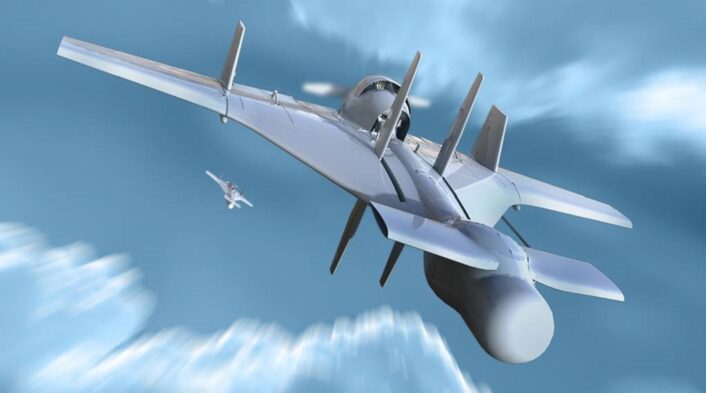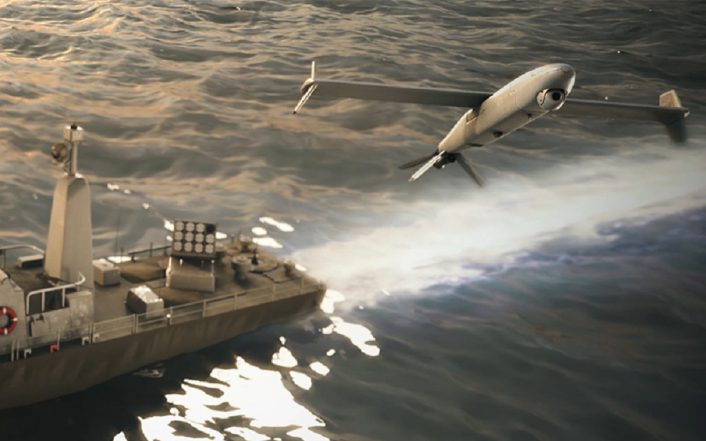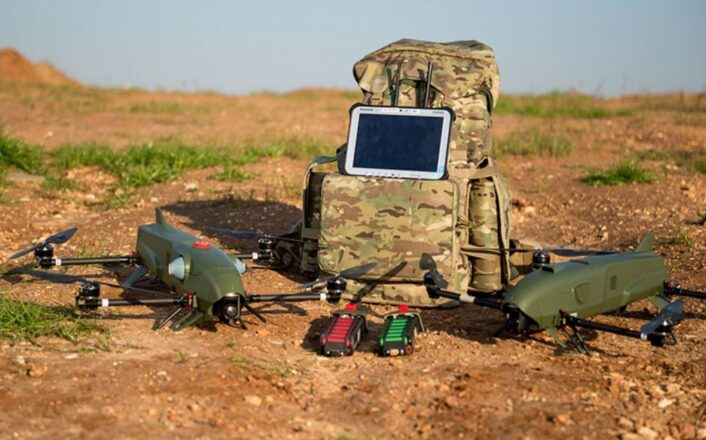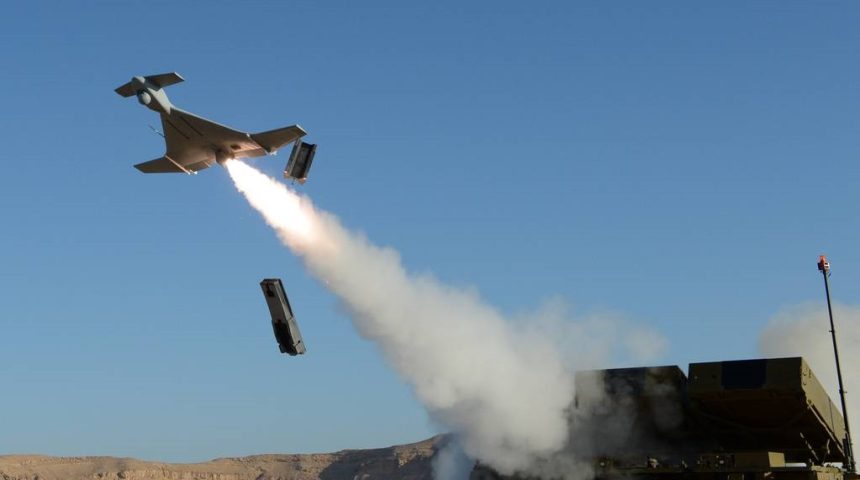Loitering munitions are becoming increasingly common in modern conflicts, providing benefits over classic munitions but also some ethical questions.
Modern conflicts are continuously evolving, and so are the technologies employed on the battlefield. One of the advanced technologies that is being increasingly seen in action during the most recent conflicts is the loitering munition. Loitering munitions, often defined as suicide drones, are precision weapons, usually with Man In The Loop (MITL) guidance, which can loiter for a certain time over a defined area while looking for a target to attack.
According to many opinions, loitering munitions can fit in the niche between cruise missile and Unmanned Combat Aerial Vehicles with some important differences from both, as these systems are designed to loiter for relatively long time compared to a cruise missile and the entire asset is expended in the attack compared to a UCAV (hence the term suicide drone). The first munitions of this kind emerged in the 1980s/1990s to be used against air defense systems during Suppression/Destruction of Enemy Air Defenses (SEAD/DEAD) missions.
Loitering munitions brought us from a one missile to one target ratio to a many to many ratio. In fact, while classic missiles are launched to one precise target whose position is already known, loitering munitions can be launched even if the target location is unknown, they just need a “killbox” where they might find multiple targets and choose one suitable for the attack. This makes them ideal for time sensitive pop-up targets that needs to be attacked immediately and can’t wait for a missile to be launched on preplanned coordinates.
One of the companies that pioneered the development of loitering munitions is IAI (Israel Aerospace Industries), with more than 35 years of experience in this sector. The development was started inside the company’s missile branch, before the creation of the Loitering Munitions Division. The company, in fact, refers to these munitions as missiles instead of drones, as the entire asset is a weapon and the capabilities which are similar to UAVs are only secondary and meant to assist the Find, Fix, Track, Target, Engage, Assess kill chain.
IAI first developed the Harpy, an autonomous anti-radiation loitering munition for SEAD/DEAD missions. Later the Harpy was joined by the Harop, which swapped its fully autonomous guidance for a Man In The Loop guidance and the anti-radiation sensor for an Electro-Optical/InfraRed (EO/IR) sensor. These two are very relevant systems in the tactical arena, designed to locate, track and destroy high quality static and mobile targets on a larger scale.
Harpy and Harop were later joined by their “little brothers” Mini Harpy and Green Dragon, designed to provide significant situational awareness and firepower in a compact envelope to small ground units and special operations forces. An even smaller one is Rotem, a lightweight and compact loitering munition based on a light multi-rotor platform and designed to be employed by just one operator to perform squad-level ISR and attack missions.

Let’s talk about these systems in detail. As we said, the first one to be developed was Harpy and, through various upgrades, it has now evolved in the Harpy NG (New Generation), which shares the same planform of the Harop and is designed to counter the most recent air defense threats thanks to the new Anti-Radiation Seeker. The upgraded variant features an extension of the radio frequencies analyzed and better flying characteristics, including longer loiter time, extended range, higher altitude.
Harpy is a “Fire and Forget” autonomous weapon, programmed on the ground and launched from canisters normally mounted on trucks at standoff ranges. Immediately after the rocket assisted launch, the munition unfolds its wings and activates its piston engine with a two-blade pusher propeller that can take it up to a top speed of 225 kts and a maximum altitude of 15,000 ft which.
The missile then performs autonomous flight to a pre-defined “Loitering Area”, in which they orbit while searching for radiating targets. The “signature” of these targets is compared with a preprogrammed database of known air defense systems and, once the target is confirmed, Harpy begins the dive that will lead to the accurate destruction of the radar system. The high precision and the warhead allow the total destruction of the radar target.
This way, Harpy can effectively perform SEAD/DEAD missions suppressing hostile air defenses for hours while autonomously searching, identifying, acquiring, attacking and destroying enemy radar emitting threats. Emitting is an important word in the last sentence, as if the enemy radar is turned off and does not emit signals, the attack is automatically aborted. IAI also emphasizes Harpy’s vertical attack capabilities, as most air defense systems have a blindspot right above their position where they can’t physically detect and/or engage targets.
Harop is very similar to Harpy but very different at the same time. They share the planform, launch canisters, the Ground Control Shelter and pretty much all the training and logistics. However, it is not limited to just SEAD/DEAD missions, as it replaces the anti-radiation sensor with an ElectroOptical/InfraRed (EO/IR) sensor and the autonomous targeting capability with a Man In The Loop guidance, enabled by a two-way data link that allows about a 200 km range.
Harop has the capability to attack any high-value and time-sensitive targets, following all the steps of the killchain. As Harpy, Harop is programmed to fly autonomously after launch to a loiter area, with the operator in the MCS periodically checking the munition’s position and status. When controlling multiple Harops, the operator has the ability to select one munition for target search and attack, while the others are monitored.
The operator can direct the selected Harop to the target area and use the video feed to select a target and to initiate the attack. The munition then dives on the target, detonating the warhead upon impact and another one can be rerouted to perform the Battle Damage Assessment if needed. Like Harpy, if the target doesn’t meet anymore the conditions for the attack before the impact, the attack can be aborted and the operator can reuse the same loitering munition for other targets during the nine-hour loiter time.
Harop has a warhead of 15 kg that can be used in a wide range of battle scenarios, including low and high intensity conflict, urban warfare and counter terror operations. The latter two scenarios are greatly benefiting from the abort capability, as it allows to avoid collateral damage, as well as the capability to attack from any direction and at any angle, from flat to vertical, both stationary and moving targets. The high-performance color CCD EO seeker with 360 degrees hemispherical coverage allows the maximum precision on target, with a circular error probability of less than one meter.

Harop has also a maritime variant, which provides an operational solution for a range of naval vessels, from offshore patrol vessels to frigates, and gives mission commanders the capability to collect intelligence, assess and strike targets both at sea or on land and at a long-range. The use of the loitering munition on naval platforms is considered an operational alternative and complementary element to employing sea-sea missiles, with a wide range of uses.
The differences of the maritime variant are limited and include some changes meant to endure the salty and corrosive marine environment and adjustments to the communication channels of the loitering munition, as the radio communications over the sea present unique problems due to the distance from land and the lack of relays that could “bounce” the signal sent from the ship to Harop, as well as the fact that the source of the command and control signal is constantly moving.
Both Harop and Harpy are not designed to be recovered, as the addition of a landing gear or parachute system would have increased the complexity and costs of the munition, as well as the weight which in turn would have led to a reduction of the flight characteristics. A simple landing gear, mounted externally, was only used during testing to allow the recovery of the prototypes for further study.
Let’s talk about the smaller brothers of Harpy and Harop. Green Dragon is a tactical, low-cost loitering munition designed to provide small ground units and special operations forces with significant situational awareness and firepower in a compact solution. Like the larger munitions we already mentioned, Green Dragon is stored, transported and launched from a sealed canister, with as many as 12-16 units carried on a light vehicle and launched upon request.
Green Dragon is designed to be easily operated and controlled from a tablet-sized electronic control panel with a tactical low-power data link to the loitering munition. The datalink allows “Non-Line of Sight” (NLOS) and “Over the Hill” operations, extending the reach of the ground troops and enabling the strike of distant or geographically concealed targets without line-of-sight. The EO/IR sensor allows Green Dragon to collect visual intelligence of the surrounding areas and locate, acquire and dive on operator designated targets.
The capabilities are pretty much the same of Harop, but on a smaller scale. The range and loiter time provided by its silent electrical motor are reduced to 50 km and up to two hours, respectively, and the warhead is of just 3 kg, but the MITL guidance is still highly accurate and allows a CEP better than 1 m. The Green Dragon operator also has the same built-in “abort and go around” capability of the larger Harop to prevent unnecessary collateral damage or mistaken targeting, as well as the capability to employ the full range from shallow to vertical attack angles.

A further enhancement in capabilities comes with Mini Harpy, which adds an anti-radiation sensor to a larger Green Dragon’s airframe becoming a loitering munition with Dual EO/IR and Anti-Radiation seeker guidance. This way, the munition provides tactical forces with the ability to suppress the area of interest for long duration and to strike immediately both emitting and non-emitting targets, effectively combining the capabilities of IAI’s two flagship loitering missiles, Harop and Harpy.
Mini Harpy can be launched from a broad range of mobile land platforms as well as marine platforms, sharing this capability with both the larger Harop and Green Dragon. There are also provisions for this munition to be air-launched, with a particular focus on combat helicopters that could greatly benefit from this capability. As for the other munitions, Mini Harpy is programmed before launch to fly to a designated loiter area, with the operator checking its status enroute and taking control for the target search.
Being equipped with two seekers, the missile can perform the targeting either fully autonomously, when using the anti-radiation seeker against emitting targets, or through the MITL guidance, when using the EO/IR sensor against non-emitting targets. In either case, the operator has control of Mini Harpy up to the last moment, including the abortion of the attack at any stage and the following recovery maneuver to return the missile to the loiter orbit for another attack run.
The last, but not least loitering munition, is completely different from the ones we just mentioned. In fact, the smallest munition in IAI’s portfolio is Rotem, a tactical system based on a lightweight and compact multi-rotor platform that is designed to be assembled in seconds and operated by a single soldier in the field. The munition is capable of lethal precision strikes both on stationary and mobile targets with same abort capability of the larger munitions and is fully recoverable.
Rotem is considered to be the first combat-proven Vertical Take-Off & Landing (VTOL) Tactical Loitering Munition already used in operations by several militaries. The extremely versatile platform can perform both squad-level ISR and attack missions with minimal planning and operational focus from the operator. The tactical kit is designed to fit in a normal backpack containing two aerial vehicles with all the required gear to allow an operational unit to use it organically as a part of their standard gear.

This game-changer small loitering device, based on a quadcopter drone platform, acts as a power multiplier for tactical forces in a range of scenarios, providing reconnaissance and attack envelope with maximum ease of use. The operator, in fact, can control Rotem via a simple and intuitive operation interface on a touchscreen tablet without distractions from other combat tasks when embedded in a squad.
Moreover, Rotem incorporates a unique safety mechanism that enables its safe return to the operator (if mission is aborted or engagement is not required) for a safe recovery, reloading a reuse in accordance with the MIL-STD-331C standard for the safety, reliability and performance characteristics of weapon system fuzes and the MIL-STD-1316E standard for safety criteria for fuzes and Safety and Arming devices. The operator can also autonomously remove the warhead, composed by two semi-exposed fragmentation grenades, should the attack capability not be required.
The quadcopter platform allows this loitering munition to be highly maneuverable and capable of high angle flank engagements, as well as advanced obstacle avoidance for urban operations in complex terrains. The modularity of Rotem is granted by an open system architecture which enables the integration of a range of IAI sensors and/or effectors, including assault warheads, counter UAS and IED systems, door breacher and target acquisition (EO/IR, COMINT, Fire Detection).
The baseline Rotem is equipped with the explosive warhead and EO/IR sensor, which are used within a 30-minute endurance to support the ground team. The standard backpacked configuration allows the extension of the endurance to 180 minutes with the additional batteries if needed. According to IAI, the quadcopter combines high-end Commercial Off The Shelf (COTS) components with the company’s technology for tracking, homing and engagement, lowering the costs.
Many autonomous modes have been added to assist the operator, like the Emergency Return Home, Nav-to-Route, Observation, Attack, Abort and ATOL (Auto Takeoff & Landing). This way the loitering munition can be employed even if the soldier is involved in a firefight, without causing a fatal distraction by diverting the attention from the engagement and reducing the situational awareness, as well as granting an immediate solution during time-critical events like ambushes or sniper attacks.
As we saw in this report, loitering munitions opened the modern warfare to many new possibilities. Nowadays there is more understanding of the benefits provided by these systems, and many militaries are surveying this technology field and acquiring/developing their own loitering munitions. This is especially true after recent events like the Nagorno-Karabakh conflict demonstrated how effective are these munitions in shaping the battlespace, even if they uncovered some ethical issues related to the autonomous target attack capabilities.
The Aviationist would like to thank IAI for the help provided in the preparation of this article, while making sure also that it would not compromise sensitive information that would preclude the safety of any parties involved and of the operators employing these advanced technologies.









